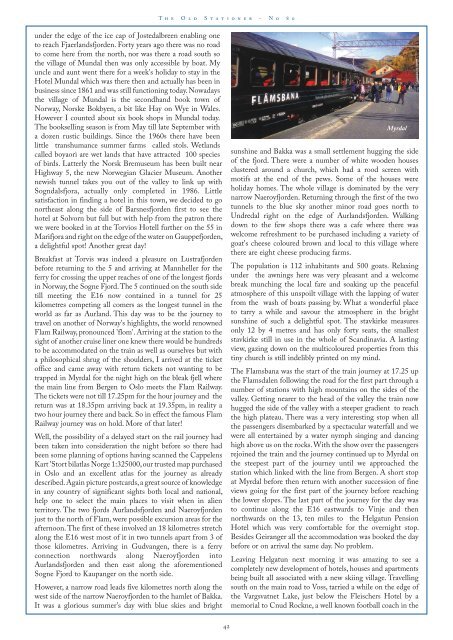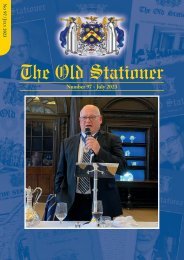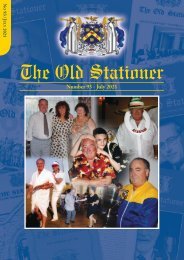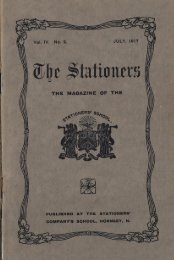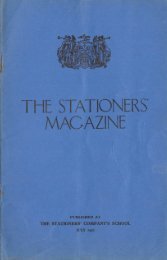OSAmag80
Create successful ePaper yourself
Turn your PDF publications into a flip-book with our unique Google optimized e-Paper software.
T h e O l d S t a t i o n e r - N o 8 0<br />
under the edge of the ice cap of Jostedalbreen enabling one<br />
to reach Fjaerlandsfjorden. Forty years ago there was no road<br />
to come here from the north, nor was there a road south so<br />
the village of Mundal then was only accessible by boat. My<br />
uncle and aunt went there for a week's holiday to stay in the<br />
Hotel Mundal which was there then and actually has been in<br />
business since 1861 and was still functioning today. Nowadays<br />
the village of Mundal is the secondhand book town of<br />
Norway, Norske Bokbyen, a bit like Hay on Wye in Wales.<br />
However I counted about six book shops in Mundal today.<br />
The bookselling season is from May till late September with<br />
a dozen rustic buildings. Since the 1960s there have been<br />
little transhumance summer farms called stols. Wetlands<br />
called boyaori are wet lands that have attracted 100 species<br />
of birds. Latterly the Norsk Bremuseum has been built near<br />
Highway 5, the new Norwegian Glacier Museum. Another<br />
newish tunnel takes you out of the valley to link up with<br />
Sogndalsfjora, actually only completed in 1986. Little<br />
satisfaction in finding a hotel in this town, we decided to go<br />
northeast along the side of Barsnesfjorden first to see the<br />
hotel at Solvorn but full but with help from the patron there<br />
we were booked in at the Torvios Hotell further on the 55 in<br />
Marifjora and right on the edge of the water on Gauppefjorden,<br />
a delightful spot! Another great day!<br />
Breakfast at Torvis was indeed a pleasure on Lustrafjorden<br />
before returning to the 5 and arriving at Mannheller for the<br />
ferry for crossing the upper reaches of one of the longest fjords<br />
in Norway, the Sogne Fjord. The 5 continued on the south side<br />
till meeting the E16 now contained in a tunnel for 25<br />
kilometres competing all comers as the longest tunnel in the<br />
world as far as Aurland. This day was to be the journey to<br />
travel on another of Norway's highlights, the world renowned<br />
Flam Railway, pronounced 'flom'. Arriving at the station to the<br />
sight of another cruise liner one knew there would be hundreds<br />
to be accommodated on the train as well as ourselves but with<br />
a philosophical shrug of the shoulders, I arrived at the ticket<br />
office and came away with return tickets not wanting to be<br />
trapped in Myrdal for the night high on the bleak fjell where<br />
the main line from Bergen to Oslo meets the Flam Railway.<br />
The tickets were not till 17.25pm for the hour journey and the<br />
return was at 18.35pm arriving back at 19.35pm, in reality a<br />
two hour journey there and back. So in effect the famous Flam<br />
Railway journey was on hold. More of that later!<br />
Well, the possibility of a delayed start on the rail journey had<br />
been taken into consideration the night before so there had<br />
been some planning of options having scanned the Cappelens<br />
Kart 'Stort bilatlas Norge 1:325000, our trusted map purchased<br />
in Oslo and an excellent atlas for the journey as already<br />
described. Again picture postcards, a great source of knowledge<br />
in any country of significant sights both local and national,<br />
help one to select the main places to visit when in alien<br />
territory. The two fjords Aurlandsfjorden and Naeroyfjorden<br />
just to the north of Flam, were possible excursion areas for the<br />
afternoon. The first of these involved an 18 kilometres stretch<br />
along the E16 west most of it in two tunnels apart from 3 of<br />
those kilometres. Arriving in Gudvangen, there is a ferry<br />
connection northwards along Naeroyfjorden into<br />
Aurlandsfjorden and then east along the aforementioned<br />
Sogne Fjord to Kaupanger on the north side.<br />
However, a narrow road leads five kilometres north along the<br />
west side of the narrow Naeroyfjorden to the hamlet of Bakka.<br />
It was a glorious summer's day with blue skies and bright<br />
Myrdal<br />
sunshine and Bakka was a small settlement hugging the side<br />
of the fjord. There were a number of white wooden houses<br />
clustered around a church, which had a rood screen with<br />
motifs at the end of the pews. Some of the houses were<br />
holiday homes. The whole village is dominated by the very<br />
narrow Naeroyfjorden. Returning through the first of the two<br />
tunnels to the blue sky another minor road goes north to<br />
Undredal right on the edge of Aurlandsfjorden. Walking<br />
down to the few shops there was a cafe where there was<br />
welcome refreshment to be purchased including a variety of<br />
goat's cheese coloured brown and local to this village where<br />
there are eight cheese producing farms.<br />
The population is 112 inhabitants and 500 goats. Relaxing<br />
under the awnings here was very pleasant and a welcome<br />
break munching the local fare and soaking up the peaceful<br />
atmosphere of this unspoilt village with the lapping of water<br />
from the wash of boats passing by. What a wonderful place<br />
to tarry a while and savour the atmosphere in the bright<br />
sunshine of such a delightful spot. The stavkirke measures<br />
only 12 by 4 metres and has only forty seats, the smallest<br />
stavkirke still in use in the whole of Scandinavia. A lasting<br />
view, gazing down on the multicoloured properties from this<br />
tiny church is still indelibly printed on my mind.<br />
The Flamsbana was the start of the train journey at 17.25 up<br />
the Flamsdalen following the road for the first part through a<br />
number of stations with high mountains on the sides of the<br />
valley. Getting nearer to the head of the valley the train now<br />
hugged the side of the valley with a steeper gradient to reach<br />
the high plateau. There was a very interesting stop when all<br />
the passengers disembarked by a spectacular waterfall and we<br />
were all entertained by a water nymph singing and dancing<br />
high above us on the rocks. With the show over the passengers<br />
rejoined the train and the journey continued up to Myrdal on<br />
the steepest part of the journey until we approached the<br />
station which linked with the line from Bergen. A short stop<br />
at Myrdal before then return with another succession of fine<br />
views going for the first part of the journey before reaching<br />
the lower slopes. The last part of the journey for the day was<br />
to continue along the E16 eastwards to Vinje and then<br />
northwards on the 13, ten miles to the Helgatun Pension<br />
Hotel which was very comfortable for the overnight stop.<br />
Besides Geiranger all the accommodation was booked the day<br />
before or on arrival the same day. No problem.<br />
Leaving Helgatun next morning it was amazing to see a<br />
completely new development of hotels, houses and apartments<br />
being built all associated with a new skiing village. Travelling<br />
south on the main road to Voss, tarried a while on the edge of<br />
the Vargsvatnet Lake, just below the Fleischers Hotel by a<br />
memorial to Cnud Rockne, a well known football coach in the<br />
42


